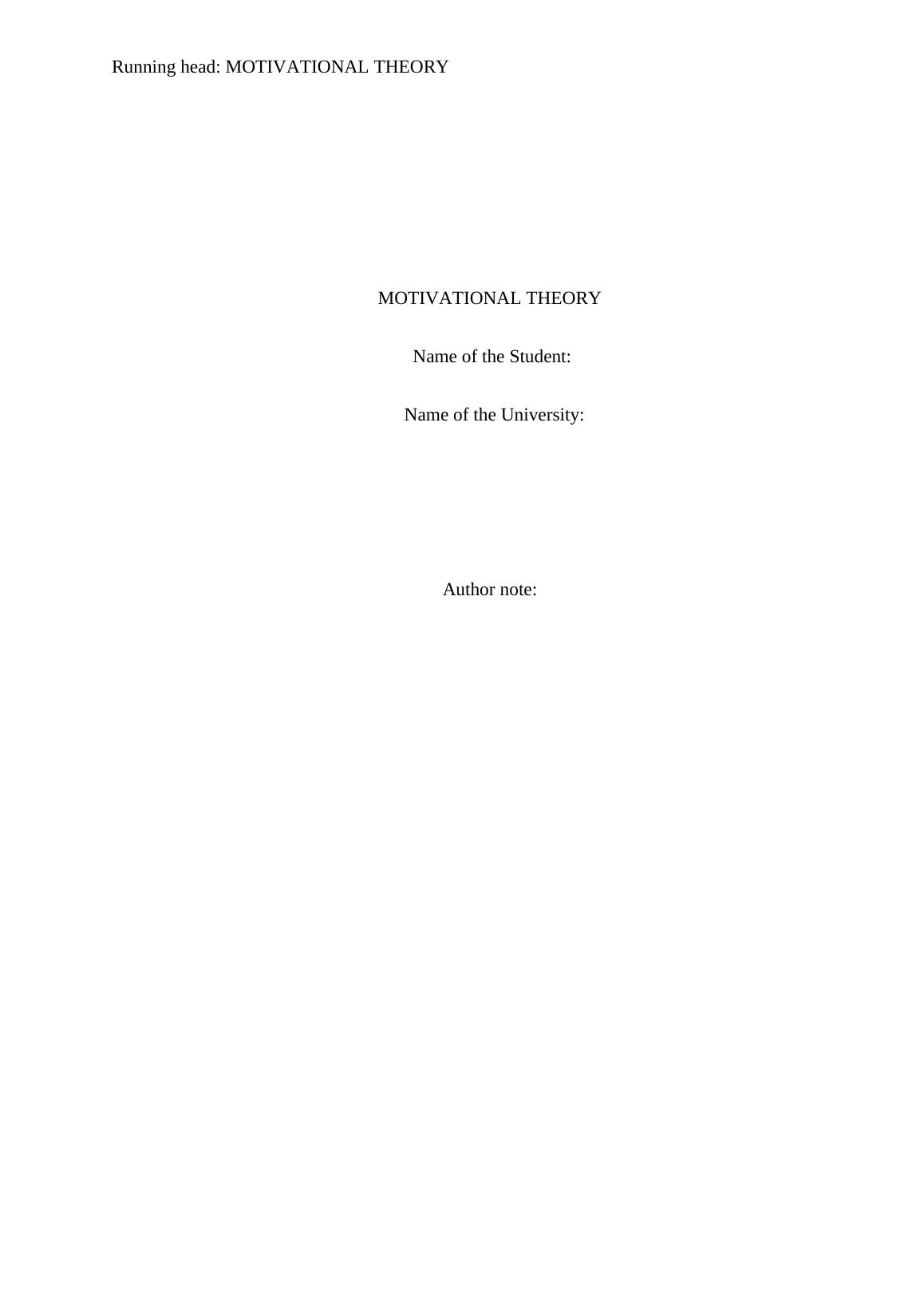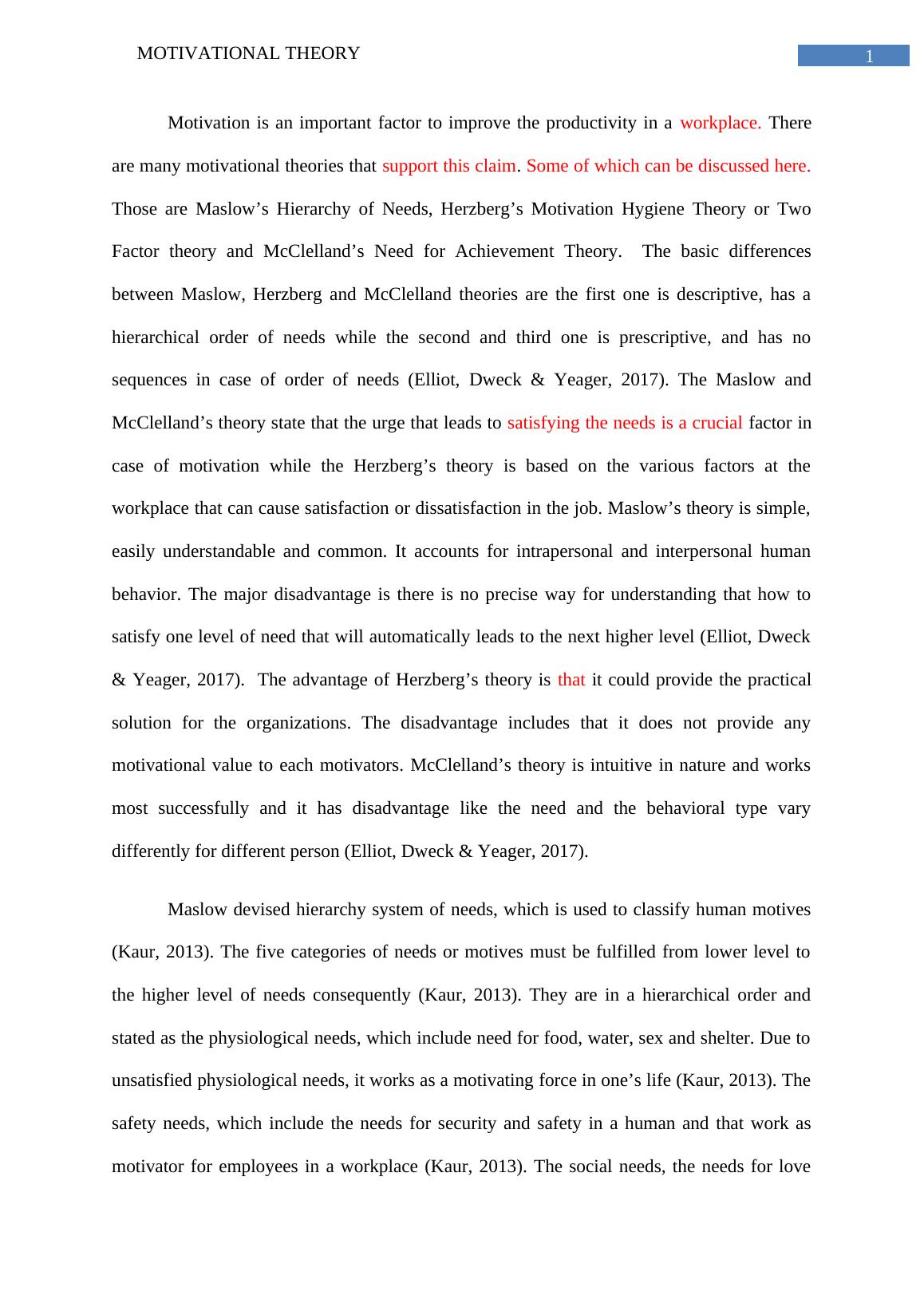Introduce to the Motivation Theory
Added on 2020-04-01
6 Pages1163 Words40 Views
Running head: MOTIVATIONAL THEORY
MOTIVATIONAL THEORY
Name of the Student:
Name of the University:
Author note:
MOTIVATIONAL THEORY
Name of the Student:
Name of the University:
Author note:

1MOTIVATIONAL THEORY
Motivation is an important factor to improve the productivity in a workplace. There
are many motivational theories that support this claim. Some of which can be discussed here.
Those are Maslow’s Hierarchy of Needs, Herzberg’s Motivation Hygiene Theory or Two
Factor theory and McClelland’s Need for Achievement Theory. The basic differences
between Maslow, Herzberg and McClelland theories are the first one is descriptive, has a
hierarchical order of needs while the second and third one is prescriptive, and has no
sequences in case of order of needs (Elliot, Dweck & Yeager, 2017). The Maslow and
McClelland’s theory state that the urge that leads to satisfying the needs is a crucial factor in
case of motivation while the Herzberg’s theory is based on the various factors at the
workplace that can cause satisfaction or dissatisfaction in the job. Maslow’s theory is simple,
easily understandable and common. It accounts for intrapersonal and interpersonal human
behavior. The major disadvantage is there is no precise way for understanding that how to
satisfy one level of need that will automatically leads to the next higher level (Elliot, Dweck
& Yeager, 2017). The advantage of Herzberg’s theory is that it could provide the practical
solution for the organizations. The disadvantage includes that it does not provide any
motivational value to each motivators. McClelland’s theory is intuitive in nature and works
most successfully and it has disadvantage like the need and the behavioral type vary
differently for different person (Elliot, Dweck & Yeager, 2017).
Maslow devised hierarchy system of needs, which is used to classify human motives
(Kaur, 2013). The five categories of needs or motives must be fulfilled from lower level to
the higher level of needs consequently (Kaur, 2013). They are in a hierarchical order and
stated as the physiological needs, which include need for food, water, sex and shelter. Due to
unsatisfied physiological needs, it works as a motivating force in one’s life (Kaur, 2013). The
safety needs, which include the needs for security and safety in a human and that work as
motivator for employees in a workplace (Kaur, 2013). The social needs, the needs for love
Motivation is an important factor to improve the productivity in a workplace. There
are many motivational theories that support this claim. Some of which can be discussed here.
Those are Maslow’s Hierarchy of Needs, Herzberg’s Motivation Hygiene Theory or Two
Factor theory and McClelland’s Need for Achievement Theory. The basic differences
between Maslow, Herzberg and McClelland theories are the first one is descriptive, has a
hierarchical order of needs while the second and third one is prescriptive, and has no
sequences in case of order of needs (Elliot, Dweck & Yeager, 2017). The Maslow and
McClelland’s theory state that the urge that leads to satisfying the needs is a crucial factor in
case of motivation while the Herzberg’s theory is based on the various factors at the
workplace that can cause satisfaction or dissatisfaction in the job. Maslow’s theory is simple,
easily understandable and common. It accounts for intrapersonal and interpersonal human
behavior. The major disadvantage is there is no precise way for understanding that how to
satisfy one level of need that will automatically leads to the next higher level (Elliot, Dweck
& Yeager, 2017). The advantage of Herzberg’s theory is that it could provide the practical
solution for the organizations. The disadvantage includes that it does not provide any
motivational value to each motivators. McClelland’s theory is intuitive in nature and works
most successfully and it has disadvantage like the need and the behavioral type vary
differently for different person (Elliot, Dweck & Yeager, 2017).
Maslow devised hierarchy system of needs, which is used to classify human motives
(Kaur, 2013). The five categories of needs or motives must be fulfilled from lower level to
the higher level of needs consequently (Kaur, 2013). They are in a hierarchical order and
stated as the physiological needs, which include need for food, water, sex and shelter. Due to
unsatisfied physiological needs, it works as a motivating force in one’s life (Kaur, 2013). The
safety needs, which include the needs for security and safety in a human and that work as
motivator for employees in a workplace (Kaur, 2013). The social needs, the needs for love

2MOTIVATIONAL THEORY
and belongingness in a human being and that reflects in an employee as an ability to work in
a team with other co-workers (Kaur, 2013). After fulfilling the social needs, esteem needs are
the next motivating needs. This needs represent the desires of an employee for status,
reputation, recognition and appreciation in a workplace. Self-actualization is the top most
need in the Maslow’s Hierarchy. The continuous process of self-development in an employee
works as a motivator (Kaur, 2013). Herzberg stated that the job satisfaction and the
dissatisfaction are the result of motivating factors (satisfiers) and hygiene factors (Latham,
2012). The motivating factors are work, responsibility, growth, recognition. The hygiene
factors are working conditions, job security, company policy, salary, personal life (Latham,
2012). Hygiene factors work as a dissatisfiers however, by removing the hygiene factors, the
dissatisfaction possibly will remove but that does not mean the employees are motivated
enough to work harder (Latham, 2012). McClelland’s Need for Achievement Theory is based
on the needs and the satisfaction of that needs (Miner, 2015). When a need stimulates a
person it works as a motivator and that person uses his behavioral pattern for fulfilling his
need. The central theme of this theory is that needs could be learned by coping in one’s
environment and then leading to one’s satisfaction of the job (Miner, 2015). According to me,
the best motivational theory for enabling the internal motivation is McClelland’s Need for
Achievement Theory. The reason is that it works directly from within and is based on human
psychology. The dominant motivators are the need for achievement, affiliation and power,
which are all internal force to express in behavior, which is also an internal factor (Elliot,
Dweck & Yeager, 2017).
The leader who uses behaviorism is the leader whose approach is behavior-focused
and provides the real marketing potential. The behavior is something that could be
conditioned according to a manner that people show specific type of responses in specific
stimuli (MALOŞ, 2012). There are two types of Behavioral studies that can be found in
and belongingness in a human being and that reflects in an employee as an ability to work in
a team with other co-workers (Kaur, 2013). After fulfilling the social needs, esteem needs are
the next motivating needs. This needs represent the desires of an employee for status,
reputation, recognition and appreciation in a workplace. Self-actualization is the top most
need in the Maslow’s Hierarchy. The continuous process of self-development in an employee
works as a motivator (Kaur, 2013). Herzberg stated that the job satisfaction and the
dissatisfaction are the result of motivating factors (satisfiers) and hygiene factors (Latham,
2012). The motivating factors are work, responsibility, growth, recognition. The hygiene
factors are working conditions, job security, company policy, salary, personal life (Latham,
2012). Hygiene factors work as a dissatisfiers however, by removing the hygiene factors, the
dissatisfaction possibly will remove but that does not mean the employees are motivated
enough to work harder (Latham, 2012). McClelland’s Need for Achievement Theory is based
on the needs and the satisfaction of that needs (Miner, 2015). When a need stimulates a
person it works as a motivator and that person uses his behavioral pattern for fulfilling his
need. The central theme of this theory is that needs could be learned by coping in one’s
environment and then leading to one’s satisfaction of the job (Miner, 2015). According to me,
the best motivational theory for enabling the internal motivation is McClelland’s Need for
Achievement Theory. The reason is that it works directly from within and is based on human
psychology. The dominant motivators are the need for achievement, affiliation and power,
which are all internal force to express in behavior, which is also an internal factor (Elliot,
Dweck & Yeager, 2017).
The leader who uses behaviorism is the leader whose approach is behavior-focused
and provides the real marketing potential. The behavior is something that could be
conditioned according to a manner that people show specific type of responses in specific
stimuli (MALOŞ, 2012). There are two types of Behavioral studies that can be found in

End of preview
Want to access all the pages? Upload your documents or become a member.
Related Documents
Coursework-1 Collaborative Activity Assignment PDFlg...
|11
|2130
|53
Theories of Motivation and Their Application in the Modern Workplacelg...
|8
|2164
|294
Motivational Theories and Their Impact on Organizationslg...
|8
|921
|352
Management, Motivation and Leadership - Deskliblg...
|19
|4402
|494
Managing a Sales Team: Motivation, Performance and Staffinglg...
|15
|2915
|475
Management Assignment | Management Skillslg...
|9
|2212
|112
